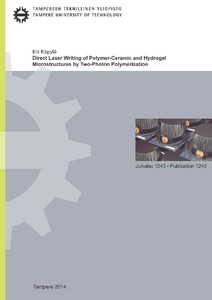Direct laser writing of polymer-ceramic and hydrogel microstructures by two-photon polymerization
Käpylä, Elli (2014)
Käpylä, Elli
Tampere University of Technology
2014
Teknis-taloudellinen tiedekunta - Faculty of Business and Technology Management
This publication is copyrighted. You may download, display and print it for Your own personal use. Commercial use is prohibited.
Julkaisun pysyvä osoite on
https://urn.fi/URN:ISBN:978-952-15-3383-9
https://urn.fi/URN:ISBN:978-952-15-3383-9
Tiivistelmä
Additive manufacturing techniques enable the fabrication of sophisticated micro- and nanostructures through computer controlled deposition of either energy, material or both. By combining these techniques with biomaterials, microstructures suitable for cell culturing and other biomedical applications can be created. Among these approaches, direct laser writing by two-photon polymerization (2PP-DLW) is a highly accurate and flexible technique that can be used for the processing of various synthetic and natural materials. 2PP-DLW is based on nonlinear two-photon absorption, which enables selective photopolymerization and realization complex three-dimensional (3D) microstructures in a single processing step.
This thesis focuses on the microfabrication of polymer-ceramic and hydrogel materials by custom built 2PP-DLW laser systems. The main objective was to determine how 2PP-DLW processing parameters affect the quality of microstructures aimed at cell culturing applications. The optimal processing conditions for a commercial polymer-ceramic material Ormocomp® were studied with the Irgacure® 127 photoinitiator and a picosecond laser system. It was found that the achievable Ormocomp® feature size could be reduced from microscale to nanoscale by careful tuning of laser power and exposure time. Within the determined fabrication window, the Ormocomp® microstructure dimensions could be tuned in a wide range by the choice of focusing optics and processing parameters. With help of these findings, Ormocomp® scaffold structures with a variable and defined degree of porosity and interconnectivity were successfully fabricated. The 85% porous scaffolds supported the attachment, viability and growth of human adipose stem cells in a six day culture.
Aimed at creating biomimetic microstructures, the 2PP-DLW processing of custom-synthetized poly(amino acid) hydrogels (poly(AA)s) was studied and compared to commercial poly(ethylene glycol) diacrylates (PEGdas). The acryloylated and methacryloylated poly(AA)s combined with the Irgacure® 2959 photoinitiator were found applicable to 2PP-DLW over a relatively wide range of processing parameters. Due to the wider fabrication window, the dimensions of poly(AA) microstructures could be tuned more than PEGda microstructures. Stable poly(AA) microstructures could be fabricated with 80% water content and with improved 3D fabrication performance with increasing acryloylation.
In the future, this work could be expanded to the fabrication of custom scaffolds for different cell types and stem cell lineages. These types of structures could combine areas of different chemical composition and porosity within a single scaffold. The poly(AA) hydrogels could also be combined with cells to fabricate cell-laden 3D microstructures.
This thesis focuses on the microfabrication of polymer-ceramic and hydrogel materials by custom built 2PP-DLW laser systems. The main objective was to determine how 2PP-DLW processing parameters affect the quality of microstructures aimed at cell culturing applications. The optimal processing conditions for a commercial polymer-ceramic material Ormocomp® were studied with the Irgacure® 127 photoinitiator and a picosecond laser system. It was found that the achievable Ormocomp® feature size could be reduced from microscale to nanoscale by careful tuning of laser power and exposure time. Within the determined fabrication window, the Ormocomp® microstructure dimensions could be tuned in a wide range by the choice of focusing optics and processing parameters. With help of these findings, Ormocomp® scaffold structures with a variable and defined degree of porosity and interconnectivity were successfully fabricated. The 85% porous scaffolds supported the attachment, viability and growth of human adipose stem cells in a six day culture.
Aimed at creating biomimetic microstructures, the 2PP-DLW processing of custom-synthetized poly(amino acid) hydrogels (poly(AA)s) was studied and compared to commercial poly(ethylene glycol) diacrylates (PEGdas). The acryloylated and methacryloylated poly(AA)s combined with the Irgacure® 2959 photoinitiator were found applicable to 2PP-DLW over a relatively wide range of processing parameters. Due to the wider fabrication window, the dimensions of poly(AA) microstructures could be tuned more than PEGda microstructures. Stable poly(AA) microstructures could be fabricated with 80% water content and with improved 3D fabrication performance with increasing acryloylation.
In the future, this work could be expanded to the fabrication of custom scaffolds for different cell types and stem cell lineages. These types of structures could combine areas of different chemical composition and porosity within a single scaffold. The poly(AA) hydrogels could also be combined with cells to fabricate cell-laden 3D microstructures.
Kokoelmat
- Väitöskirjat [4768]
